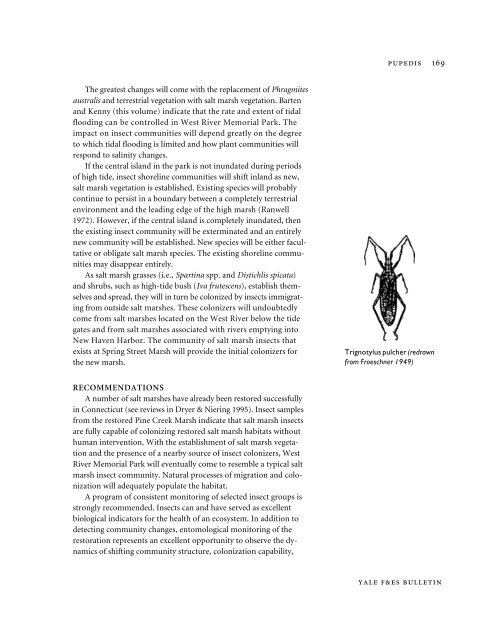Aquatic Insects of the West River and Salt Marshes ... - Yale University
Aquatic Insects of the West River and Salt Marshes ... - Yale University
Aquatic Insects of the West River and Salt Marshes ... - Yale University
You also want an ePaper? Increase the reach of your titles
YUMPU automatically turns print PDFs into web optimized ePapers that Google loves.
PUPEDIS 169The greatest changes will come with <strong>the</strong> replacement <strong>of</strong> Phragmitesaustralis <strong>and</strong> terrestrial vegetation with salt marsh vegetation. Barten<strong>and</strong> Kenny (this volume) indicate that <strong>the</strong> rate <strong>and</strong> extent <strong>of</strong> tidalflooding can be controlled in <strong>West</strong> <strong>River</strong> Memorial Park. Theimpact on insect communities will depend greatly on <strong>the</strong> degreeto which tidal flooding is limited <strong>and</strong> how plant communities willrespond to salinity changes.If <strong>the</strong> central isl<strong>and</strong> in <strong>the</strong> park is not inundated during periods<strong>of</strong> high tide, insect shoreline communities will shift inl<strong>and</strong> as new,salt marsh vegetation is established. Existing species will probablycontinue to persist in a boundary between a completely terrestrialenvironment <strong>and</strong> <strong>the</strong> leading edge <strong>of</strong> <strong>the</strong> high marsh (Ranwell1972). However, if <strong>the</strong> central isl<strong>and</strong> is completely inundated, <strong>the</strong>n<strong>the</strong> existing insect community will be exterminated <strong>and</strong> an entirelynew community will be established. New species will be ei<strong>the</strong>r facultativeor obligate salt marsh species. The existing shoreline communitiesmay disappear entirely.As salt marsh grasses (i.e., Spartina spp. <strong>and</strong> Distichlis spicata)<strong>and</strong> shrubs, such as high-tide bush (Iva frutescens), establish <strong>the</strong>mselves<strong>and</strong> spread, <strong>the</strong>y will in turn be colonized by insects immigratingfrom outside salt marshes. These colonizers will undoubtedlycome from salt marshes located on <strong>the</strong> <strong>West</strong> <strong>River</strong> below <strong>the</strong> tidegates <strong>and</strong> from salt marshes associated with rivers emptying intoNew Haven Harbor. The community <strong>of</strong> salt marsh insects thatexists at Spring Street Marsh will provide <strong>the</strong> initial colonizers for<strong>the</strong> new marsh.Trignotylus pulcher (redrawnfrom Froeschner 1949)RECOMMENDATIONSA number <strong>of</strong> salt marshes have already been restored successfullyin Connecticut (see reviews in Dryer & Niering 1995). Insect samplesfrom <strong>the</strong> restored Pine Creek Marsh indicate that salt marsh insectsare fully capable <strong>of</strong> colonizing restored salt marsh habitats withouthuman intervention. With <strong>the</strong> establishment <strong>of</strong> salt marsh vegetation<strong>and</strong> <strong>the</strong> presence <strong>of</strong> a nearby source <strong>of</strong> insect colonizers, <strong>West</strong><strong>River</strong> Memorial Park will eventually come to resemble a typical saltmarsh insect community. Natural processes <strong>of</strong> migration <strong>and</strong> colonizationwill adequately populate <strong>the</strong> habitat.A program <strong>of</strong> consistent monitoring <strong>of</strong> selected insect groups isstrongly recommended. <strong>Insects</strong> can <strong>and</strong> have served as excellentbiological indicators for <strong>the</strong> health <strong>of</strong> an ecosystem. In addition todetecting community changes, entomological monitoring <strong>of</strong> <strong>the</strong>restoration represents an excellent opportunity to observe <strong>the</strong> dynamics<strong>of</strong> shifting community structure, colonization capability,YALE F&ES BULLETIN
















